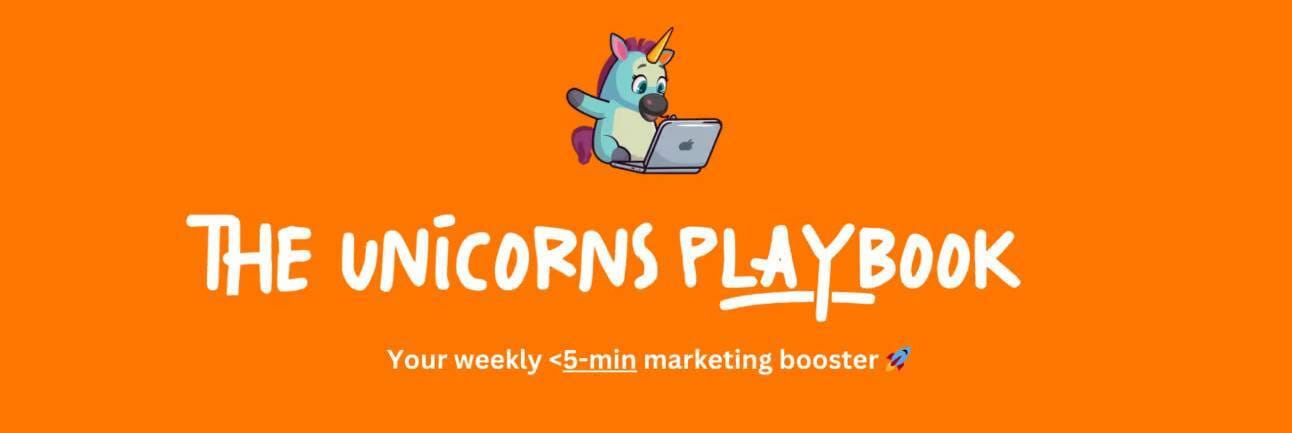- The Unicorns Playbook
- Posts
- 📚 K=c*i, The Threat-Thwarting Technique & A Shocking Ad
📚 K=c*i, The Threat-Thwarting Technique & A Shocking Ad
Smart Marketing in 5 minutes!

Smart Marketing in 5 minutes!
Weekly Growth Strategy
The Viral Coefficient: Engineering Word-of-Mouth Growth 🦄

Want to turn your users into your most powerful marketing force?
Meet the viral coefficient – the math behind explosive, word-of-mouth growth.
What is it:
The viral coefficient (K) measures how many new users each existing user brings in.
It's like calculating the R0 of your product's contagiousness.
Why it works:
It taps into trust, social proof, and FOMO.
It's like having your users do your marketing for you – for free.
Dropbox's Success Story:
Dropbox nailed it, growing from 100,000 to 4 million users in just 15 months.
Their secret?
A referral program offering free space that made sharing irresistible.
The result?
By 2016, Dropbox reached 500 million users.
How to use it:
Measure your current K (invites sent * conversion rate).
Identify your weak link: invites sent or conversion rate?
Design share triggers into your core product experience.
Implement double-sided rewards to incentivize both inviters and invitees.
A/B test relentlessly to optimize your viral loop.
Remember, you're not just optimizing metrics – you're engineering a self-propagating growth machine.
How this Growth Loop Works:
A user joins and experiences value
User hits strategically designed share trigger
User invites friends, driven by incentives
New users join through invitations
New users restart the cycle, amplifying growth
Ready to engineer viral growth for your product?
Marketing Psychology Playbook
The Threat-Thwarting Technique: Turning Fears into Fierce Marketing 🧠

What is it? 🤔
Have you ever bought insurance "just in case" or double-checked your door locks after watching a crime show?
That's the Threat-Thwarting Technique – the power of addressing fears – in action.
How does it work? 🧠
It taps into our natural instinct for self-preservation and risk aversion.
Presenting a threat followed by a solution triggers our desire for safety and prompts action.
This psychological mechanism can turn perceived dangers into opportunities for your brand to save the day.
How to Use the Threat-Thwarting Technique in Your Marketing 🚀
Identify relevant threats, present the danger clearly, offer your product/service as the solution, use vivid imagery, and balance fear with hope.
Remember, moderation is key – motivate action without causing panic.
Who's doing it right? 🌟
👉 Volvo’s “A Million More” Campaign
Volvo's "A Million More" campaign showcases real accident survivors, emphasizing their vehicles' life-saving potential.

👉 Duracell’s “Protect Your Family” Ads
Duracell's "Protect Your Family" ads position their batteries as essential for emergency preparedness, playing on fear of powerlessness.

👉 Listerine’s “Kills Germs That Cause Bad Breath” Campaign
Listerine's "Kills Germs That Cause Bad Breath" campaign taps into social anxiety, offering their product as a shield against embarrassment.

The Threat-Thwarting Technique Takeaway 💡
When applied ethically, it can boost engagement, drive conversions, and even promote public safety.
Position your brand as the hero in the face of threats – and watch as fear transforms into fierce customer loyalty!
Ad Playbook
✍ United Colors of Benetton's "UNHATE" Controversial Campaign

United Colors of Benetton, the Italian fashion brand, sparked global controversy with its "UNHATE" campaign launched in November 2011.
Let's analyze this provocative ad and examine its impact on the brand's image and social message.
What we like 👍
Benetton takes a bold stance on promoting peace and reconciliation:
The ad directly challenges political tensions by depicting world leaders in unexpected, intimate embraces.
The use of photorealistic imagery creates an immediate, visceral impact that's hard to ignore.
The campaign demonstrates Benetton's commitment to social commentary:
By featuring contentious political figures, Benetton positions itself as a brand unafraid to address global conflicts.
The ads spark conversation about tolerance and understanding across ideological divides.
The visual concept is simple yet powerful:
The kissing imagery is universally understood and provokes an immediate emotional response.
The large "UNHATE" text provides a clear, memorable message that ties the campaign together.
What We Don't Like 👎
The campaign's use of unauthorized images of political and religious leaders raises ethical concerns and legal issues.
The shocking nature of the imagery overshadows the intended message of tolerance for some viewers.
The ads risk trivializing complex geopolitical conflicts by reducing them to a simple embrace.
Many felt it crossed a line by manipulating the images of real individuals without their consent, showing disrespect for cultural and political sensitivities.
What We Would Do Differently 🧑🏾⚖️
1. Collaborate with willing public figures or use actors to create similar imagery without legal complications.
2. Develop a more comprehensive campaign that goes beyond shock value to explain and promote the concept of "unhating."
3. Create opportunities for real dialogue around the issues raised, perhaps through events or social media engagement.
4. Include diverse representations of reconciliation beyond just male political leaders.
5. Ensure all imagery respects cultural and political sensitivities, avoiding manipulation of real individuals' likenesses without consent.
This Benetton ad campaign serves as a prime example of shock advertising in the 21st century.
While it succeeded in generating massive publicity and discussion, it did so by courting controversy and legal action.
The campaign's mixed reception (praised for creativity while criticized for insensitivity) demonstrates the fine line between provocative marketing and ethical missteps.
Lesson 🎓
Shock value can backfire and even alienate your customers.
While the "UNHATE" campaign certainly grabbed attention, it also risked alienating potential customers and damaging the brand's reputation.
Brands must balance the desire for publicity with respect for cultural norms and individual rights.
We hope you enjoyed it! 🦄
Tell us, how did this email land for you? |